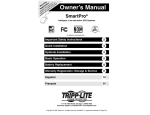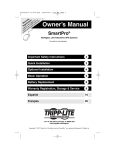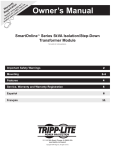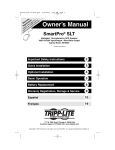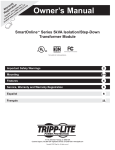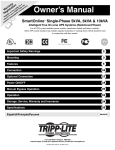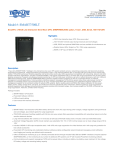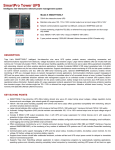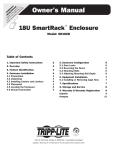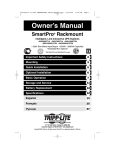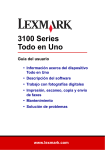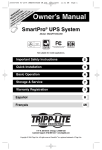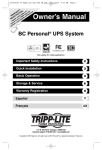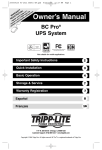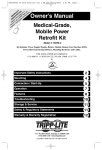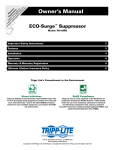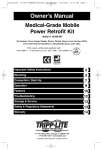Download Tripp Lite SMART750SLT User's Manual
Transcript
y nt on for a Lite nty a i p r ar at day rip rra W istr ine to EE T m/wa g nl FR .co Reister owin aipplite g o .tr Re ce t ww n !w a ch uct od r p Owner’s Manual SmartPro® SLT Intelligent, Line-Interactive UPS System Model: SMART750SLT • 100/110/120V Input/Output • 750VA Capacity • Sine-Wave Output Not suitable for mobile applications. Important Safety Instructions 2 Quick Installation 3 Optional Installation 4 Basic Operation 5 Battery Replacement 7 Warranty Registration, Storage & Service 8 Espanol 9 Francais 18 1111 W. 35th Street, Chicago, IL 60609 USA Customer Support: (773) 869-1234 • www.tripplite.com Copyright © 2005 Tripp Lite. All rights reserved. SmartPro® is a registered trademark of Tripp Lite. Important Safety Instructions Quick Installation SAVE THESE INSTRUCTIONS 1 With the UPS disconnected from This manual contains instructions and warnings that should be followed during the installation, operation and storage of all Tripp Lite UPS Systems. Failure to heed these warnings will void your warranty. UPS Location Warnings • Install your UPS indoors, away from excess moisture or heat, conductive contaminants, dust or direct sunlight. • For best performance, keep the indoor temperature between between 32º F and 104º F (0º C and 40º C). • Leave adequate space around all sides of the UPS for proper ventilation. utility power, use a small tool to set the Voltage Dip Switch to match your input voltage. (All models are preset to the 120V setting.) 2 Plug the UPS into an outlet on a 1 dedicated circuit. NOTE! after you plug the UPS into a live AC outlet, the UPS will automatically charge its batteries,* but will not supply power to its outlets until it is turned ON. * The BATTERY CHARGE LED will be the only LED illuminated UPS Connection Warnings • Connect your UPS directly to a properly grounded AC power outlet. Do not plug the UPS into itself; this will damage the UPS. • Do not modify the UPS's plug, and do not use an adapter that would eliminate the UPS’s ground connection. • Do not use extension cords to connect the UPS to an AC outlet. • If the UPS receives power from a motor-powered AC generator, the generator must provide clean, filtered, computer-grade output. Equipment Connection Warnings • Do not use Tripp Lite UPS Systems for life-support applications in which a malfunction or failure of an Tripp Lite UPS System could cause failure or significantly alter the performance of a life-support device. • Do not connect surge suppressors or extension cords to the output of your UPS. This might damage the UPS and will void the surge suppressor and UPS warranties. Battery Warnings 3 Plug your equipment into the UPS. Select outlets provide both battery backup and surge protection; plug computers, monitors and other critical devices into these outlets.* Select outlets provide surge protection only; plug printers and other non-essential devices into these outlets. Do not plug high-draw equipment into the battery backup/surge protection outlets. * Your UPS is designed to support electronic equipment only. You will overload the UPS if the total VA rating for all equipment connected through the battery backup/surge protection outlets exceeds the UPS's Output Capacity. To find your equipment's VA ratings, look on their nameplates. If the equipment is listed in amps, multiply the number of amps by 120 to determine VA. (Example: 1 amp × 120 = 120 VA). If you are unsure if you have overloaded the UPS's outlets, see “OUTPUT LOAD LEVEL” LED description. 4 Turn the UPS ON. • Batteries can present a risk of electrical shock and burn from high short-circuit current. Observe proper precautions. There are no user-serviceable parts inside the UPS. Do not open the UPS except to perform battery replacement. Do not open batteries. Do not short or bridge the battery terminals with any object. Unplug and turn off the UPS before performing battery replacement. Use tools with insulated handles. Battery replacement should be performed only by authorized service personnel using the same number and type of batteries (Sealed Lead-Acid). Do not dispose of the batteries in a fire. The batteries are recyclable. Refer to your local codes for disposal requirements or in the USA only call 1-800-SAV-LEAD or 1-800-8-BATTERY (1-800-822-8837) or visit www.rbrc.com for recycling information. Tripp Lite offers a complete line of UPS System Replacement Battery Cartridges (R.B.C.).Visit Tripp Lite on the Web at www.tripplite.com/support/ battery/index.cfm to locate the specific replacement battery for your UPS. 2 Press and hold the “STANDBY” button for one second. The alarm will beep once briefly after one second has passed. Release the button. 3 2 3 4 Optional Installation Basic Operation These connections are optional. Your UPS will function properly without these connections. 1 USB and RS-232 Serial Communications Use the included USB cable 1a and/or DB9 serial cable 1b to connect the communication port on your computer to the communication port of your UPS. Install on your computer the Tripp Lite PowerAlert Software appropriate to your computer’s operating system. Consult your PowerAlert manual for more information. 1a “STANDBY” Button • To turn the UPS ON: with the UPS plugged into a live AC wall outlet,* press and hold the STANDBY button for about one second.** Release the button. If utility power is absent, you can "cold-start" the UPS (i.e.: turn it ON and supply power for a limited time from its batteries***) by pressing and holding the STANDBY button for about two seconds.** • To turn the UPS OFF: with the UPS ON and receiving utility power, press and hold the STANDBY button for one second.** Then unplug the UPS from the wall outlet. The UPS will be completely OFF. * After you plug the UPS into a live AC outlet, the UPS will automatically charge its batteries, but will not supply power to its outlets until it is turned ON. ** The alarm will beep once briefly after the indicated interval has passed. *** If fully charged. 2 Telephone/Network Protection Jacks Your UPS has jacks that protect against surges over a telephone line or a network dataline. Using telephone network data cables, connect your wall jack to the UPS jack marked “IN.” Connect your equipment to the UPS jack marked “OUT.” Make sure the equipment you connect to the UPS's jacks is also protected against surges on the AC line. Buttons 1b Not compatible with PoE (Power Over Ethernet) applications. 2 “MUTE/TEST” Button • To Silence (or “Mute”) UPS Alarms: briefly press and release the MUTE/TEST button.* Note: continuous alarms (warning you to immediately shut down connected equipment) cannot be silenced. • To Run a Self-Test: with your UPS plugged in and turned ON, press and hold the MUTE/TEST button for two seconds.* Continue holding the button until the alarm beeps several times and the UPS performs a self test. See “Results of a Self-Test” below. Note: you can leave connected equipment on during a self-test. Your UPS, however, will not perform a self-test if it is not turned ON (see “STANDBY” Button description). CAUTION! Do not unplug your UPS to test its batteries. this will remove safe electrical grounding and may introduce a damaging surge into your network connections. Results of a Self-Test: The test will last approximately 10 seconds as the UPS switches to battery to test its load capacity and battery charge. The “POWER” LED will be flashing and the “OUTPUT LOAD LEVEL” and “BATTERY CHARGE” LEDs will be lit and the UPS alarm will sound. • If the “OUTPUT LOAD LEVEL” LED remains lit red and the alarm continues to sound after the test, the UPS's outlets are overloaded. To clear the overload, unplug some of your equipment and run the self test repeatedly until the “OUTPUT LOAD LEVEL” LED is no longer lit red and the alarm is no longer sounding. CAUTION! Any overload that is not corrected by the user immediately following a self-test may cause the UPS to shut down and cease supplying output power in the event of a blackout or severe brownout. • If the “BATTERY WARNING” LED remains lit and the alarm continues to sound after the test, the UPS batteries need to be recharged or replaced. Allow the UPS to recharge continuously for 12 hours, and repeat the selftest. If the LED remains lit, contact Tripp Lite for service. If your UPS requires battery replacement, visit www.tripplite.com/support/battery/ index.cfm to locate the specific Tripp Lite replacement battery for your UPS. * The alarm will beep once briefly after the indicated interval has passed. 4 5 Basic Operation Basic Operation (continued) Indicator Lights (continued) Other UPS Features All Indicator Light descriptions apply when the UPS is plugged into a wall outlet and turned ON. “POWER” LED: this green LED lights continuously when the UPS is ON and supplying connected equipment with AC power from a utility source. The LED flashes and an alarm sounds (4 short beeps followed by a pause) to indicate the UPS is operating from its internal batteries during a blackout or severe brownout. If the blackout or severe brownout is prolonged, you should save files and shut down your equipment since internal battery power will eventually be depleted. See “BATTERY CHARGE” LED description below. “VOLTAGE CORRECTION” LED: this green LED lights continuously whenever the UPS is automatically correcting high or low AC voltage on the utility line without the assistance of battery power. The UPS will also emit a slight clicking noise. These are normal, automatic operations of the UPS, no action is required on your part. “OUTPUT LOAD LEVEL” LEDs: These multicolored LEDs indicate the approximate electrical load of equipment connected to the UPS's AC outlets: green (light load), yellow (medium load) and red (overload). If the red LED is either illuminated continuously or flashing, clear the overload immediately by unplugging some of your equipment from the outlets until the yellow or green LED illuminates. CAUTION! Any overload that is not corrected by the user immediately may cause the UPS to shut down and cease supplying output power in the event of a blackout or severe brownout. “BATTERY CHARGE” LEDs: When the UPS is operating from utility power, these LEDs indicates the approximate charge state of the UPS's internal batteries: red indicates the batteries are beginning to charge; yellow indicates the batteries are roughly midway through charging; and green indicates the batteries are fully charged. When the UPS is operating from battery power during a blackout or severe brownout, these multicolor LEDs indicate the approximate amount of energy (ultimately affecting runtime) that the UPS's batteries will provide: red indicates a low level of energy; yellow indicates a medium level of energy; and green indicates a high level of energy. Since the runtime performance of all UPS batteries will gradually deplete over time, it is recommended that you periodically perform a self-test (see “MUTE/TEST” Button description) to determine the energy level of your UPS batteries BEFORE a blackout or severe brownout occurs. During a prolonged blackout or severe brownout, you should save files and shut down your equipment since battery power will eventually be depleted. When the red LED illuminates and an alarm sounds continuously, this indicates that the UPS's batteries are nearly out of power and UPS shutdown is imminent. “BATTERY WARNING” LED: this LED lights yellow and an alarm sounds intermittently after you initiate a self test (See “MUTE/TEST” Button description) to indicate the UPS batteries need to be recharged or replaced. Allow the UPS to recharge continuously for 12 hours, and repeat the self-test. If the LED continues to light, contact Tripp Lite for service. If your UPS requires battery replacement, visit www.tripplite.com. "SITE WIRING FAULT" LED: This yellow LED will be lit if the UPS detects a problem with the wiring of the AC outlet you connect it to. If this occurs, have the outlet inspected by a qualified electrician. Note that while the UPS will detect many common wiring faults, including a missing ground, reversed polarity and overloaded neutral circuits, it cannot detect every conceivable wiring problem. 6 USB Port RS-232 (DB9 port) AC Receptacles: These output receptacles provide your connected equipment with AC line power during normal operation and battery power during power outages. The UPS protects equipment connected to these receptacles against damaging surges and line noise. Select outlets provide both battery backup and surge protection for computers, monitors and other critical devices into these outlets. Select outlets provide surge protection only for printers and other non-essential devices that draw large amounts of power. Communication Ports (USB and RS-232): These ports connect your UPS to any workstation or server. Use with Tripp Lite's PowerAlert Software and included cables to enable your computer to automatically save open files and shut down equipment during a blackout. Also use PowerAlert Software to monitor a wide variety of AC line power and UPS operating conditions. Consult your PowerAlert Software manual or contact Tripp Lite Customer Support for more information. See “USB Communications” and “RS-232 Serial Communications” in the “Optional Installation” section for installation instructions. Telephone/Network Protection Jacks: These jacks protect your equipment against surges over a telephone/network data line. Connecting your equipment to these jacks is optional. Your UPS will work properly without this connection. Not compatible with PoE (Power Over Ethernet) applications. Accessory Slot: Remove the small cover panel from this slot to install optional accessories to remotely monitor and control your UPS. Refer to your accessory’s manual for installation instructions. Contact Tripp Lite Customer Support at (773) 869-1234 for more information, including a list of available SNMP, networking management and connectivity products. Fan: The fan cools the UPS's internal components. It operates only when the UPS is in battery backup mode, is charging its batteries or is carrying a heavy electrical load. Battery Replacement 1 Battery Replacement Door: Under normal conditions, the original battery in your UPS will last several years. Battery replacement should be performed only by qualified service personnel. Refer to “Battery Warnings” in the Safety section. Should your UPS require battery replacement, visit Tripp Lite on the Web at www.tripplite.com/support/ battery/index.cfm to locate the specific replacement battery for your UPS. 1 Carefully pull the front panel away from the UPS. Place front panel on top of the unit. Remove the battery support bar. 2 2 Remove old batteries. Carefully pull the batteries from the UPS and disconnect them. 3 Connect new batteries. Connect the new batteries in exactly the same manner as the old ones: positive (red) connectors together and negative (black) connectors together. Carefully push batteries back into the UPS. 3 4 Reassemble UPS. Reinstall the battery support bar and replace the front panel. 7 Warranty Registration Visit www.tripplite.com/warranty today to register the warranty for your new Tripp Lite product. You'll be automatically entered into a drawing for a chance to win a FREE Tripp Lite product!* Manual del propietario * No purchase necessary. Void where prohibited. Some restrictions apply. See website for details. SmartPro® SLT Storage & Service Storage CAUTION! Your UPS has an internal power source. Its outlets may still deliver current, even after the UPS is unplugged, until the UPS is completely turned OFF (deactivated). Before storing your UPS, turn it completely OFF: with the UPS ON and receiving utility power, press and hold the STANDBY button for one second (an alarm will beep once briefly after the interval has passed); then, unplug the UPS from the wall outlet. If you store your UPS for an extended period of time, recharge the UPS batteries once every three months: plug the UPS into a wall outlet; allow it to charge for 4 to 6 hours; and then unplug it and place it back in storage. Note: after you plug the UPS in, it will automatically begin charging its batteries; however, it will not supply power to its outlets (see Quick Installation section). If you leave your UPS batteries discharged for an extended period of time, they will suffer a permanent loss of capacity. Sistemas UPS inteligentes, interactivos Modelo: SMART750SLT • Entrada/salida de 100/110/120V • Capacidad 750VA • Salida de onda sinusoidal No conveniente para los usos móviles. Instrucciones de seguridad importantes 10 Instalación rápida 11 1. Review the installation and operation instructions in this manual to ensure that the service problem does not originate from a misreading of the instructions. Instalación opcional 12 2. If the problem continues, do not contact or return the UPS to the dealer. Instead, call Tripp Lite at (773) 869-1233. A service technician will ask for the UPS's model number, serial number and purchase date and will attempt to correct the problem over the phone. Operación básica 13 Reemplazo de batería 16 Almacenamiento y servicio técnico 17 Service Before returning your UPS for service, follow these steps: 3. If the problem requires service, the technician will issue you a Returned Material Authorization (RMA) number, which is required for service. If you require packaging, the technician can arrange to send you proper packaging. Securely pack the UPS to avoid damage during shipping. Do not use Styrofoam beads for packaging. Any damages (direct, indirect, special, incidental or consequential) to the UPS incurred during shipment to Tripp Lite or an authorized Tripp Lite service center is not covered under warranty. UPS Systems shipped to Tripp Lite or an authorized Tripp Lite service center must have transportation charges prepaid. Mark the RMA number on the outside of the package. If the UPS System is within the 2-year warranty period, enclose a copy of your sales receipt. Return the UPS for service using an insured carrier to the address given to you by the Tripp Lite service technician. FCC Part 68 Notice (United States Only) English 1 Francais 18 If your Modem/Fax Protection causes harm to the telephone network, the telephone company may temporarily discontinue your service. If possible, they will notify you in advance. If advance notice isn't practical, you will be notified as soon as possible. You will be advised of your right to file a complaint with the FCC. Your telephone company may make changes in its facilities, equipment, operations or procedures that could affect the proper operation of your equipment. If it does, you will be given advance notice to give you an opportunity to maintain uninterrupted service. If you experience trouble with this equipment's Modem/Fax Protection, please call Tripp Lite Technical Support at (773) 869-1234 for repair/warranty information. The telephone company may ask you to disconnect this equipment from the network until the problem has been corrected or you are sure the equipment is not malfunctioning. There are no repairs that can be made by the customer to the Modem/Fax Protection. This equipment may not be used on coin service provided by the telephone company. Connection to party lines is subject to state tariffs. (Contact your state public utility commission or corporation commission for information.) Regulatory Compliance Identification Numbers For the purpose of regulatory compliance certifications and identification, your Tripp Lite product has been assigned a unique series number. The series number can be found on the product nameplate label, along with all required approval markings and information. When requesting compliance information for this product, always refer to the series number. The series number should not be confused with the marking name or model number of the product. This product designed and engineered in the USA. 8 Note on Labeling Two symbols are used on the label. V~ : AC Voltage V : DC Voltage 1111 W. 35th Street, Chicago, IL 60609 USA Soporte al cliente: (773) 869-1234 • www.tripplite.com Copyright ©2005 Tripp Lite. Todos los derechos reservados. SmartPro® es una marca comercial registrada de Tripp Lite. Instrucciones de seguridad importantes Instalación rápida GUARDE ESTAS INSTRUCCIONES 1 Con el UPS desconectado de la Este manual contiene instrucciones y advertencias que deben seguirse durante la instalación, la operación y el almacenamiento de todos los UPS de Tripp Lite. La no observancia de estas advertencias anulará su garantía. Advertencias sobre la ubicación del UPS • Instale su UPS bajo techo, lejos de la humedad, el calor, los contaminantes conductores, el polvo o la luz solar directa. • Para un mejor funcionamiento, mantenga la temperatura en el interior entre 32º F y 104º F (0º C y 40º C). • Deje una cantidad adecuada de espacio alrededor de todos los lados del UPS para una adecuada ventilación. Advertencias sobre la conexión del UPS • Conecte su UPS directamente a una toma de corriente de CA puesta a tierra apropiadamente. No conecte el UPS a si mismo ya que podría dañarse. • No modifique el enchufe del UPS ni emplee un adaptador que elimine su conexión a tierra. • No use cordones de extensión para conectar el UPS a una toma de CA. • Si el UPS recibe energía de un generador de CA accionado por motor, el generador debe proporcionar una salida limpia y filtrada de grado computadora. Advertencias sobre la conexión de equipos • No utilice un UPS de Tripp Lite para aplicaciones de soporte de vida en las que el funcionamiento defectuoso o una falla del mismo pudiera causar la falla o una alteración importante en el funcionamiento de un dispositivo de soporte de vida. • No conecte supresores de sobretensiones ni cordones de extensión a la salida de su UPS. Esto puede sobrecargarlo y anular su garantía y la del supresor de sobretensiones. Advertencias sobre la batería • Debido a que las baterías presentan un peligro de choque eléctrico y quemaduras por las altas corrientes de cortocircuito, tome las precauciones adecuadas. No deseche las baterías en un incinerador. No abra las baterías. No ponga los terminales de la batería en corto o en puente con ningún objeto. Apague y desconecte el UPS antes de reemplazar la batería. Sólo debe cambiar las baterías personal técnico debidamente capacitado. Use herramientas con mangos aislados y reemplace las baterías existentes con el mismo número y tipo de baterías nuevas (plomo-ácido selladas). Las baterías del UPS son reciclables. Consulte la reglamentación local para los requisitos de disposición de desechos; para los EE.UU. solamente consulte estas fuentes para información sobre reciclaje: 1-800-SAV-LEAD (1-800-728-5323); 1-800-8-BATTERY (1-800-822-8837); www.rbrc.com. Tripp Lite ofrece una línea completa de Cartuchos de reemplazo de batería para UPS (R.B.C.). Visite Tripp Lite en la web en www.tripplite.com/support/battery/index.cfm para localizar la batería de reemplazo específica para su UPS. 10 energía de la red, use una herramienta pequeña para ajustar el conmutador DIP de voltaje de modo que coincida con su voltaje de entrada. (Todos los modelos están ajustados a 120 V en forma predeterminada.) 1 2 Conecte el UPS en una salida de un circuito dedicado. Nota: En cuanto conecte el UPS, comenzará a cargar sus baterías,* but will not supply power to its outlets until it is turned ON. * El LED BATTERY CHARGE (CARGA DE BATERÍA) será el único iluminado. 2 3 Conecte sus equipos con el UPS Las salidas exclusivas proporcionarán respaldo de batería y protección contra sobretensiones; conecte su computadora, monitor y otros dispositivos críticos aquí.* Las salidas exclusivas proporcionarán protección contra sobretensiones solamente; conecte su impresora y otros dispositivos no esenciales aquí. No tape más últimas impresoras en estas salidas. * Su UPS está diseñado para dar soporte únicamente a equipos de computación. Usted provocará una sobrecarga del UPS si la potencia nominal en VA de todos los equipos que conecte supera la Capacidad de Salida del UPS (vea las Especificaciones). Para averiguar la potencia nominal en VA de sus equipos, consulte las placas de identificación. Si el equipo está expresado en amp, multiplique la cantidad de amp por 120 para determinar los VA. (Ejemplo: 1 amp × 120 = 120 VA). Si no está seguro de si ha sobrecargado las salidas del UPS, vea la descripción del LED "OUTPUT LOAD LEVEL" (NIVEL DE CARGA DE SALIDA). 4 Encienda (ON) el UPS. Presione y mantenga presionado el botón “STANDBY” durante un segundo. La alarma emitirá un pitido brevemente después de pasado un segundo. Suelte el botón. 11 3 4 Instalación opcional Operación básica Estas conexiones son opcionales. Su UPS funcionará correctamente sin ellas. 1 Comunicaciones USB y serie RS-232 Use el cable USB 1a incluido y/o el cable serie DB9 1b para conectar el puerto de comunicaciones de su computadora con el puerto de comunicaciones de su UPS. Instale en su computadora el software PowerAlert de Tripp Lite apropiado para su sistema operativo. Consulte su manual de PowerAlert para mayor información. 1a Botón “STANDBY” (Reserva) • Para encender el UPS: Con el UPS conectado en una toma de CA con energía*, presione y mantenga presionado el botón “STANDBY” (Reserva) por un segundo.** Suelte el botón. Si no hay energía de la red, puede "arrancar en frío" el UPS (es decir, encenderlo y suministrar energía de sus baterías por un tiempo limitado***) presionando y manteniendo presionado el botón “STANDBY” (Reserva) durante un segundo.** • Para apagar el UPS: Con el UPS encendido y recibiendo energía de la red, presione y mantenga presionado el botón “STANDBY” (Reserva) urante un segundo.** Luego desconecte el UPS de la toma de corriente. El UPS se apagará. * Después de conectar el UPS en una toma de CA con energía, el equipo (en modo "Standby") cargará automáticamente sus baterías, pero no suministrará energía a sus salidas hasta que sea encendido. ** La alarma emitirá un pitido brevemente después de pasado el intervalo indicado. *** Si está completamente cargada. 2 Teléfono/gatos de conexión de red Su UPS tiene conectores que lo protegen contra sobretensiones en la línea telefónica. Usando cordones adecuados para teléfono o para red, conecte su conector de pared al conector del UPS marcado “IN.” Cerciórese el equipo que usted conecta a los gatos de UPS se protege también contra oleadas en la línea de C.A. Botones (Panel frontal) 1b No compatible con aplicaciones PoE (Energía sobre Ethernet). 2 Botón “MUTE/TEST” (Silencio/Prueba) • Para silenciar las alarmas UPS: Presione brevemente el botón MUTE/TEST (Silencio/Prueba) y luego suéltelo. • Para ejecutar una auto-prueba: Con su UPS conectado y encendido, presione y mantenga presionado el botón MUTE/TEST (Silencio/Prueba) por dos segundos.* Siga presionando el botón hasta que la alarma suene varias veces y el UPS realice una auto-prueba. Vea “Resultados de una auto-prueba” más abajo. Nota: Puede dejar equipos conectados durante una auto-prueba. Sin embargo, el UPS, no realizará una auto-prueba si no está encendido (vea la descripción del Botón "STANDBY"). ¡PRECAUCIÓN! No desconecte su UPS para probar sus baterías. Esto eliminaría la conexión de seguridad a tierra y podría introducir una sobretensión dañina en sus conexiones de red. Resultados de una auto-prueba: La prueba durará cerca de 10 segundos mientras el UPS conmuta a batería para probar su capacidad de carga y la recarga de la batería Si el LED “OUTPUT LOAD LEVEL” (Nivel de Carga de Salida) permanence encendido rojo y la alarma continúa sonando después de la prueba, las salidas del UPS están sobrecargadas. Para eliminar la sobrecarga, desconecte algo de su equipo y ejecute la auto-prueba repetidamente hasta que el LED ya no esté encendido rojo y la alarma ya no esté sonando. ¡PRECAUCIÓN! Cualquier sobrecarga que no sea corregida por el usuario inmediatamente después de una auto-prueba puede causar que el UPS se apague y deje de suministrar energía de salida en el caso de una falla del servicio eléctrico o una baja de voltaje. • Si el LED “BATTERY WARNING” (Advertencia de batería) sigue encendido y la alarma continúa sonando después de la prueba, las baterías del UPS deben recargarse o reemplazarse. Permita que el UPS se recargue continuamente por 12 horas y repita la auto-prueba. Si el LED permanece encendido, contacte con Tripp Lite para obtener servicio. Si su UPS requiere el reemplazo de su batería, visite www.tripplite.com para localizar la batería de reemplazo Tripp Lite específica para su UPS. * La alarma emitirá un pitido brevemente después de pasado el intervalo indicado. 12 13 Operación básica Operación básica (continúa) LED “BATTERY WARNING” (Advertencia de batería): Este LED se enciende rojo y una alarma suena en forma intermitente después de iniciar una auto-prueba (vea la descripción del botón “MUTE/TEST” (SILENCIO/PRUEBA)) para indicar que las baterías del UPS deben ser recargadas o reemplazadas. Permita que el UPS se recargue continuamente por 12 horas y repita la auto-prueba. Si el LED sigue encendido, contacte con Tripp Lite para que le brinden servicio. Si su UPS requiere el reemplazo de su batería,visite www.tripplite.com LED “SITE WIRING FAULT” (Falla del cableado local): Este LED rojo se encenderá si el UPS detecta algún problema con el cableado del tomacorriente al que se está conectando. En este caso, haga revisar el tomacorriente por un electricista calificado. Aunque el UPS puede detectar muchas fallas communes de cableado, como una tierra ausente, polaridad invertida y circuitos del neutro sobrecargados, no puede detectar todos los problemas de cableado. Luces indicadoras Todas las descripciones de luces indicadoras se aplican cuando el UPS está conectado en un tomacorriente y encendido. LED “POWER” (Alimentación): Este LED verde se enciende permanentemente cuando el UPS está encendido y proporcionando energía de CA al equipo conectado desde el suministro de red. El LED destella y una alarma suena (4 pitidos cortos seguidos de una pausa) para indicar que el UPS está operando con sus baterías internas durante una falla del servicio eléctrico o una severa baja de voltaje. Si la falla o la baja de voltaje es muy prolongada, debe guardar sus archivos y apagar su equipo ya que la energía de la batería interna finalmente se agotará. Vea la descripción del LED "BATTERY CHARGE" (Carga de batería). LED “VOLTAGE CORRECTION” (Corrección de voltaje): Este LED verde se enciende en forma permanente cuando el UPS está corrigiendo automáticamente el voltaje de CA alto o bajo en la línea de la red sin la ayuda de energía de baterías. El UPS también emitirá un ligero clic. Estas son operaciones normales y automáticas del UPS y no requieren de ninguna acción de su parte. Otras funciones del UPS LEDs “OUTPUT LOAD LEVEL” (NIVELDE CARGADE SALIDA): Estos LEDs multicolor indica la carga eléctrica aproximada del equipo conectado a las salidas de CA del UPS. Se encenderá desde verde (carga ligera) a amarillo (carga media) y a rojo (sobrecarga) Si el LED está rojo (ya sea iluminado permanentemente o destellando), elimine la sobrecarga de inmediato desconectando algo de su equipo de las salidas hasta que el LED cambie de rojo a amarillo (o verde). ¡PRECAUCIÓN! Cualquier sobrecarga que no sea corregida por el usuario inmediatamente puede causar que el UPS se apague y deje de suministrar energía de salida en el caso de un falla del servicio eléctrico o una baja de voltaje. LEDs “BATTERY CHARGE” (CARGA DE BATERÍA): Cuando el UPS opera con la energía de la red, Estos LEDs multicolor indica el estado aproximado de carga de las baterías internas del UPS; el rojo indica que las baterías están comenzando a cargarse; el amarillo indica que las baterías están aproximadamente a media recarga; y el verde indica que las baterías están totalmente cargadas. Cuando el UPS opera con energía de las baterías durante una falla del servicio eléctrico o una baja de voltaje severa, este LED indica la
This document in other languages
- español: Tripp Lite SMART750SLT















